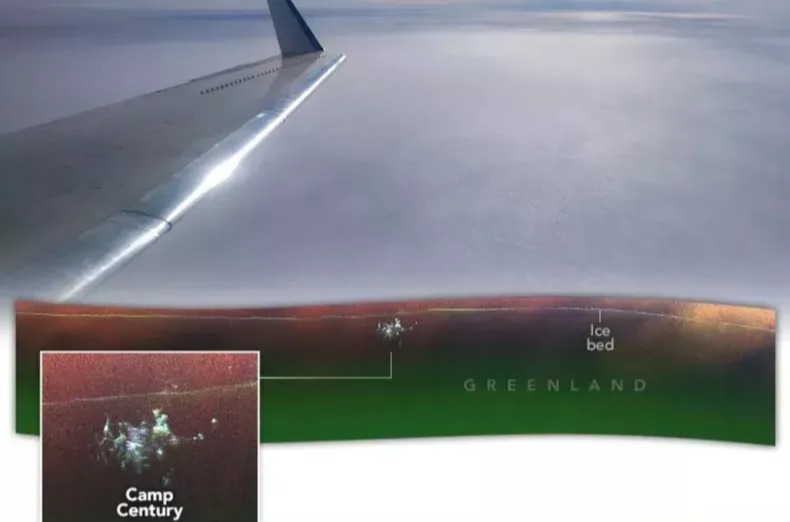NASA scientist takes stunning photo of vast ice sheet – and accidentally discovers top secret ‘city’ buried deep beneath
Deep under the ice, a NASA scientist on a routine research expedition unintentionally found an amazing treasure.
Chad Greene’s plane’s radar picked up the remains of an enigmatic “city” while he was taking a breathtaking picture of the enormous Greenland Ice Sheet.
As it happens, Greene happened onto Camp Century, a former covert Cold War military installation.
In April, while flying over northern Greenland, around 150 miles east of Pituffik Space Base, he made the shocking discovery.
The plane’s UAVSAR (Uninhabited Aerial Vehicle Synthetic Aperture Radar) detected an unexpected signal as it was calibrating radar sensors to examine the bedrock underlying the Greenland Ice Sheet.
The long-buried remains of Camp Century, an underground network of tunnels and buildings constructed by the US military in 1959 during one of the most heated times of the Cold War, were what emerged on the radar.
More on Soviet Union
For its time, Camp Century—also known as the City Under the Ice—was an engineering marvel.
The US Army Corps of Engineers constructed the facility, which included 21 interconnecting tunnels totaling more than 9,800 feet and concealed beneath 100 feet of Greenland’s ice sheet.
It was advertised as a scientific research station on paper.
under actuality, however, Camp Century was a front for Project Iceworm, a secret scheme to conceal a system of nuclear missiles under the ice that could attack the Soviet Union.
The camp was powered by the PM-2A, a cutting-edge portable nuclear reactor that provided heat and electricity to keep things running in the bitterly cold Arctic.
Inside abandoned Antarctic clifftop ghost station where Soviet boffins battled -90C gales 1000s of miles from anywhere
The shaky ice proved to be a major barrier in spite of its lofty objectives.
The US abandoned Project Iceworm in 1967 as it became unfeasible due to shifting and melting ice.
As the base was naturally sealed off, the nuclear reactor was taken out, but other things, including hazardous waste, were left behind and finally buried in the ice.
For many years, the actual objective of Camp Century was kept a close secret.
Only a few years later, the US government told Denmark, the country that oversees Greenland, about the entire scope of Project Iceworm.
Alex Gardner, a cryospheric scientist at NASA’s Jet Propulsion Laboratory (JPL), stated, “We were searching for the bed of the ice, and out pops Camp Century.”
The team was first unaware of what they had discovered.
However, particular structures inside the base’s architecture that matched old plans of the camp’s layout were later discovered by radar data.
“Our goal was to calibrate, validate, and understand the capabilities and limitations of UAVSAR for mapping the ice sheet’s internal layers and the ice-bed interface,” Greene added, describing the surprising nature of the discovery.
Rather, they caught a spooky look into history preserved beneath the surface.
Compared to previous ground-penetrating radar scans, this sophisticated radar technique offered significantly more detail, enabling researchers to produce a new map of Camp Century’s remnants.
Even though the complex is in ruins, the map displays the tunnels and facilities with extraordinary clarity, demonstrating the inventiveness of its creation.
Camp Century is still a reminder of the Cold War’s aspirations, resourcefulness, and secrecy.
Read More on The US Sun
The base’s nuclear reactor was a daring step into Arctic research, and at its prime, it symbolized the pinnacle of military and scientific progress.
However, its deserted tunnels today act as a chilling reminder of the political and environmental damage that period left behind.
Note: Every piece of content is rigorously reviewed by our team of experienced writers and editors to ensure its accuracy. Our writers use credible sources and adhere to strict fact-checking protocols to verify all claims and data before publication. If an error is identified, we promptly correct it and strive for transparency in all updates, feel free to reach out to us via email. We appreciate your trust and support!















